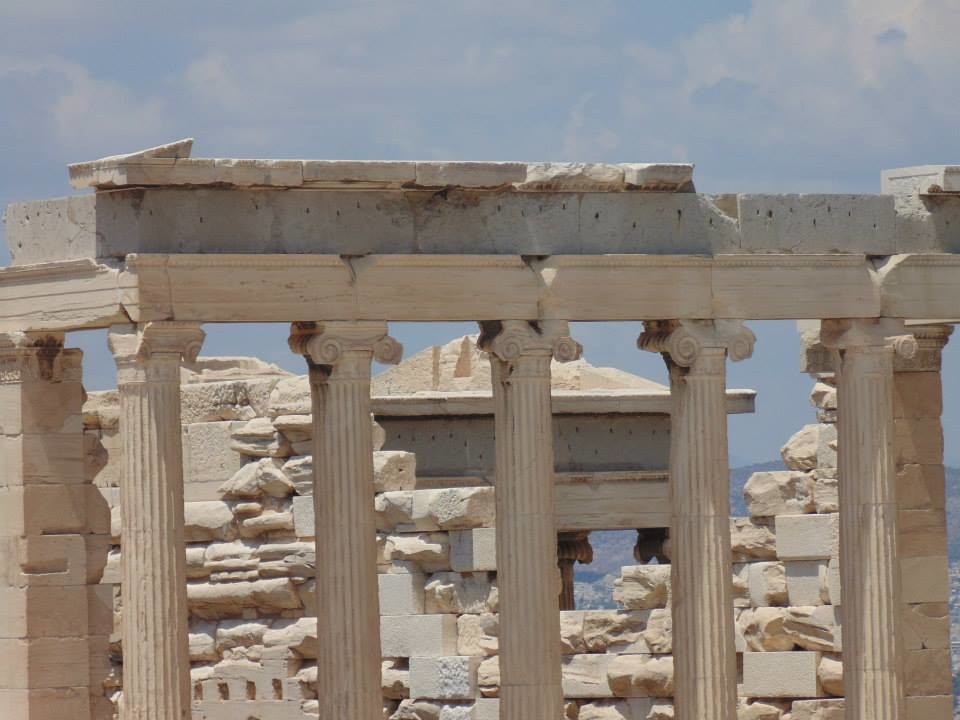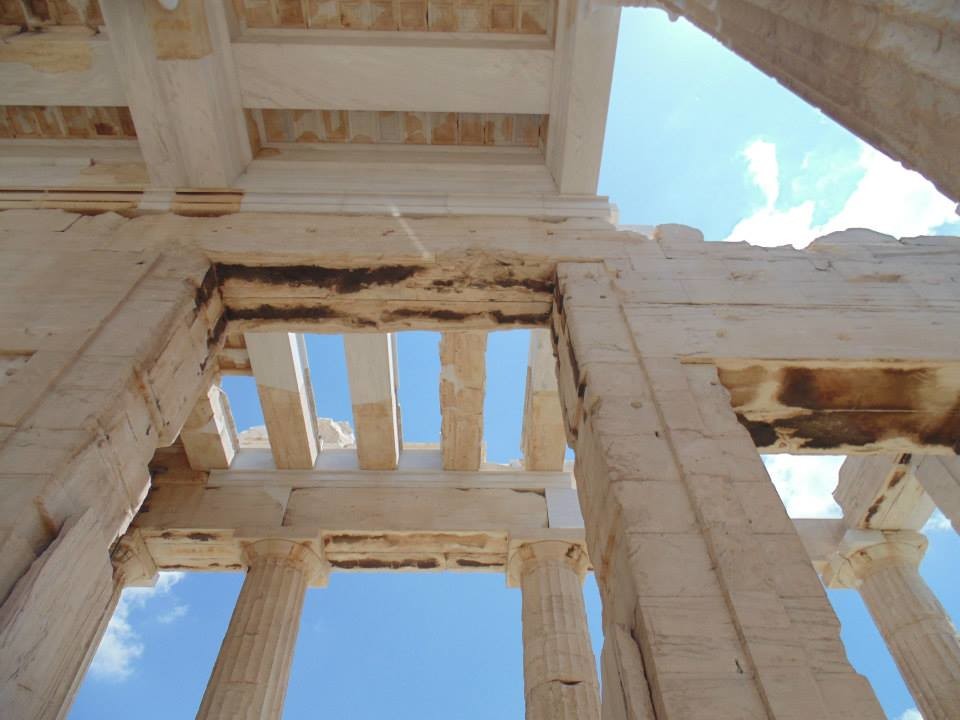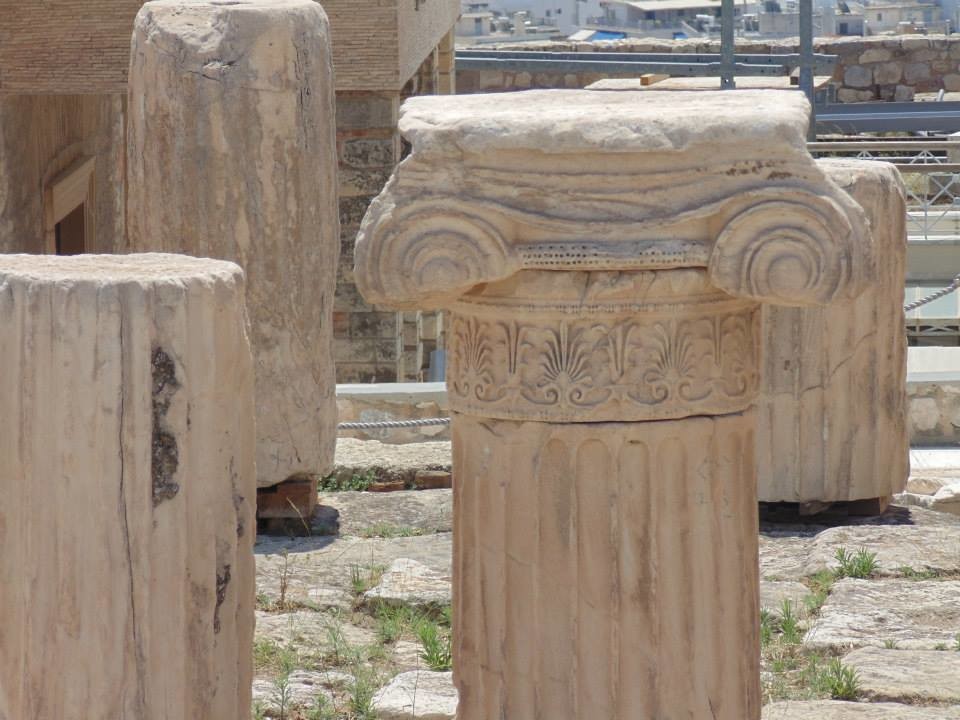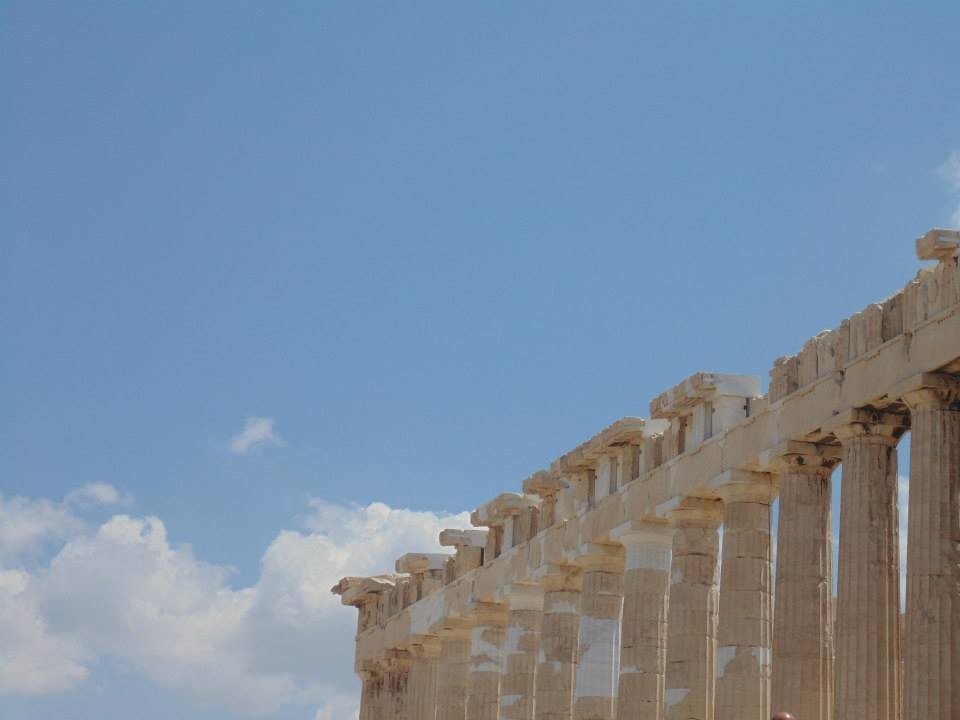
John Bailey (1750–1819), View of the Parthenon from the Propylea. Hand-coloured aquatint after Edward Dodwell, 1819.
11 January 2018
A building from Athens’ golden age
The Parthenon on the Acropolis of Athens was built between 447 and 438 BC as a temple dedicated to the goddess Athena Parthenos. The word parthénos (παρθένος) meant ‘maiden, girl’ or ‘virgin, unmarried woman’.

A reconstruction of how the Acropolis may have looked in ancient times, including the Parthenon. Illustration by Kate Morton.
The temple’s great size and lavish use of white marble was intended to show off the city’s power and wealth at the height of its empire, under the statesman Pericles. It was the centrepiece of an ambitious building programme centred on the Acropolis.

Some of the sculptures from the east pediment of the Parthenon.
The temple was richly decorated with sculptures, designed by the famous artist Pheidias, which took until 432 BC to complete. The pediments and metopes illustrate episodes from Greek myth, while the frieze represents the people of Athens in a religious procession. Inside the building stood a colossal image of Athena Parthenos, constructed of gold and ivory by Pheidias and probably dedicated in 438 BC.
You can find out a bit more about Greek architecture and what some of these terms mean in this blog post.
The sculptures in ancient times
Sculptures carved in the round filled the pediments (the triangular gables) at either end of the building.

A reconstruction of the Parthenon showing the location of one of the pediments. Illustration by Kate Morton.
The pediment sculptures and metopes illustrate episodes from Greek myth, and include the famous head of a horse of Selene (the moon goddess) and the river god Ilissos.

Head of a horse of Selene and the river god Ilissos from the east and west pediments of the Parthenon.
Metopes (rectangular slabs carved in high relief) were placed above the architrave (the lintel above the columns) on the outside of the temple.

An illustration showing the location of the pediment, metopes and frieze on the Parthenon.
The metopes illustrate episodes from Greek myth, including the battle of the Centaurs and Lapiths.

Marble metope from the Parthenon showing the battle between a Centaur and a Lapith. Athens, 447–438 BC.
The frieze (carved in low relief) ran around all four sides of the building inside the colonnade.

A reconstruction of the Parthenon showing the location of the frieze. Illustration by Kate Morton.
While the pediment sculptures and metopes depicted scenes from Greek myth, as was usual for the sculpture on Greek temples, the frieze breaks with all tradition as it shows the people of Athens in a religious procession. The Athenians on the frieze are not really portraits of ordinary people though. Instead, they are shown as an ideal community. The Athenians of Pericles’ time wanted to be remembered at their best by generations to come.
Pheidias was the most famous sculptor of all antiquity. He is best known as the artistic director of the Athenian building programme, including the Parthenon sculptures and the colossal gold and ivory statue of Athena Parthenos that stood inside the Parthenon.

Replica of the Athena Parthenon statue in Nashville by Alan Le Quire. Image from Wikimedia Commons. Photo: Dean Dixon.
We don’t know much about his life. He trained in the workshop of Ageladas of Argos. He worked mostly in Athens but also transferred his workshop to Olympia, where he constructed in gold and ivory the colossal gold and ivory seated Zeus – one of the seven wonders of the ancient world.
A history of the building
The Parthenon has a long and complex history. The building was altered and the sculptures were damaged over the course of the centuries. It began nearly 2,500 years ago as a temple dedicated to Athena.
Around AD 500 it was converted into a Christian church (the church of the Virgin Mary of the Athenians) and remained so for a thousand years. At this time, the whole of the middle section of the east pediment was removed, destroying a dozen statues. Part of the east frieze was taken down, and almost all of the metopes on the east, north and west sides were deliberately defaced.

William Pars (c. 1742–1782), detail of the east front of the Parthenon with a mosque behind. Pen and grey ink and watercolour, with bodycolour, over graphite, 1765.
Mainland Greece was conquered by the Ottoman empire by 1460 and the building became a mosque in the early 1460s. When Athens was under siege by the Venetians in 1687, the Parthenon was used as a gunpowder store. A huge explosion blew the roof off and destroyed a large portion of the remaining sculptures. The building has been a ruin ever since.
The sculptures as museum objects
By 1800 only about half of the original sculptural decoration remained. From 1801, after obtaining permission from the Ottoman authorities, the British ambassador to the Ottoman empire Lord Elgin removed about half of the remaining sculptures from the fallen ruins and the building.
Elgin was passionate about ancient Greek art and transported the sculptures to Britain at his own expense. Their arrival in London made a profound impression upon European art and taste, at a time when the European Enlightenment was revising its idea of what art should be.

Archibald Archer, The Temporary Elgin Room constructed to display the Parthenon sculptures, with portraits of staff, a trustee and visitors. Oil painting on canvas, 1819.
These sculptures were first seen from 1807 in Lord Elgin’s temporary museum. However, Elgin had bankrupted himself transporting the sculptures to Britain. In 1816 Parliament decided to acquire the collection for the British Museum. Since 1817 the sculptures have always been on display to the public in the British Museum, free of charge.

The Parthenon sculptures as they were displayed in 1923 at the British Museum. This is now Room 17. Photo by Donald Macbeth.
The Parthenon sculptures in the British Museum are 247 feet (around 75 metres) of the original 524 feet (around 160 metres) of frieze, 15 of the 92 metopes, 17 figures from the two pediments, and various pieces of architecture from the building.

Sculptures from the west pediment of the Parthenon on display in Room 18 in the British Museum.
About half of the surviving sculptures remained in Athens, including extensive remains of the metopes (especially from the east, north and west of the building), the frieze (especially the north and west sides) and the pediments. In the 1970s the Greek government began a programme of restoration of the Acropolis monuments. As part of this work, all the architectural sculptures from the Parthenon have been removed to the Acropolis Museum, and all the Parthenon sculptures are now museum objects.
Most of the sculptures are roughly equally divided between Athens and London, but important pieces are also held by other major European museum including the Louvre and Vatican Museums.
Inspiration for artists
The Parthenon sculptures have inspired artists and writers for generations, from John Keats to Henry Moore. Perhaps the most influential of these was the French sculptor Auguste Rodin, who saw in Pheidias a kindred spirit and artistic mentor.

Auguste Rodin (1840–1917), Study of the Parthenon south frieze cavalcade. Graphite and pen and ink, before 1870. © Musée Rodin. Photo: Jean de Calan.
The Parthenon sculptures are iconic works of art. They play a central part in the story of art and will continue to inspire artists in the future.
Discover how Rodin was inspired by the Parthenon sculptures and see a selection of them on display in the exhibition Rodin and the art of ancient Greece (26 April – 29 July 2018).
Sponsored by Bank of America Merrill Lynch.
Sponsored by Bank of America Merrill Lynch.
===============================================================
L'Acropole et le Parthénon, vestiges incontournables

L'entrée pour visiter ce haut lieu culturel, architectural et historique est gratuite pour les jeunes étudiants, probablement pour nous inciter à lever nos yeux sur notre passé.

Nous avons visité ce site en cherchant nous même les informations intéressantes sur internet, nous en avons trouvé concernant les grands monuments mais aussi sur les plus subtiles détails.

Les deux incontournables, Acropole et Parthénon, attirent beaucoup de touristes. Et davantage lorsque le ciel est bleu et permet d'admirer ces édifices dans toute leur splendeur.

Nous avons ensuite visité le célèbre musée du Parthénon, vraiment super, qui se trouve non loin de là.
Une journée d'enrichissement d'esprit ne nous a pas fait de tort.
Malheureusement, lors de notre visite, il y avait des travaux de restauration, ce qui gachait un peu la vue mais permettra aux générations futures d'encore entrevoir le passé, grâce au travail du présent.
